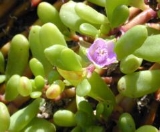
Sesuvium portulacastrum
Encyclopedia
Sesuvium portulacastrum, commonly known as shoreline purslane or (ambiguously) "sea purslane
", is a sprawling perennial herb that grows in coastal areas throughout much of the world.
, and it has remained at that name ever since, with the exception of an unsuccessful 1891 attempt by Otto Kuntze
to transfer the species into a new genus as Halimus portulacastrum.
y clay
, coastal limestone
and sandstone
, tidal flats and salt marsh
es, throughout much of the world. It is native to Africa
, Asia
, Australia
, North America
and South America
, and has naturalised in many places where it is not indigenous.
Sea Purslane
Sea Purslane may refer to:* Halimione portulacoides* Sesuvium portulacastrum...
", is a sprawling perennial herb that grows in coastal areas throughout much of the world.
Description
It grows as a sprawling perennial herb up to 30 centimetres (11.8 in) high, with thick, smooth stems up to 1 metres (3.3 ft) long. It has smooth, fleshy, glossy green leaves that are linear or lanceolate, from 10–70 mm (0.393700787401575–2.8 in) long and 2–15 mm (0.078740157480315–0.590551181102362 in) wide. Flowers are pink or purple.Taxonomy
It was first published as Portulaca portulacastrum by Carl Linnaeus in 1753. Six years later Linnaeus transferred it into SesuviumSesuvium
Sesuvium is a genus of flowering plants in the ice plant family, Aizoaceae. The roughly eight species it contains are commonly known as sea-purslanes.-Selected species:* Sesuvium crithmoides Welw. – Tropical Sea-purslane...
, and it has remained at that name ever since, with the exception of an unsuccessful 1891 attempt by Otto Kuntze
Otto Kuntze
Otto Carl Ernst Kuntze was a German botanist.-Biography:Otto Kuntze was born in Leipzig.An apothecary in his early career, he published an essay entitled Pocket Fauna of Leipzig. Between 1863 and...
to transfer the species into a new genus as Halimus portulacastrum.
Distribution and habitat
It grows in sandSand
Sand is a naturally occurring granular material composed of finely divided rock and mineral particles.The composition of sand is highly variable, depending on the local rock sources and conditions, but the most common constituent of sand in inland continental settings and non-tropical coastal...
y clay
Clay
Clay is a general term including many combinations of one or more clay minerals with traces of metal oxides and organic matter. Geologic clay deposits are mostly composed of phyllosilicate minerals containing variable amounts of water trapped in the mineral structure.- Formation :Clay minerals...
, coastal limestone
Limestone
Limestone is a sedimentary rock composed largely of the minerals calcite and aragonite, which are different crystal forms of calcium carbonate . Many limestones are composed from skeletal fragments of marine organisms such as coral or foraminifera....
and sandstone
Sandstone
Sandstone is a sedimentary rock composed mainly of sand-sized minerals or rock grains.Most sandstone is composed of quartz and/or feldspar because these are the most common minerals in the Earth's crust. Like sand, sandstone may be any colour, but the most common colours are tan, brown, yellow,...
, tidal flats and salt marsh
Salt marsh
A salt marsh is an environment in the upper coastal intertidal zone between land and salt water or brackish water, it is dominated by dense stands of halophytic plants such as herbs, grasses, or low shrubs. These plants are terrestrial in origin and are essential to the stability of the salt marsh...
es, throughout much of the world. It is native to Africa
Africa
Africa is the world's second largest and second most populous continent, after Asia. At about 30.2 million km² including adjacent islands, it covers 6% of the Earth's total surface area and 20.4% of the total land area...
, Asia
Asia
Asia is the world's largest and most populous continent, located primarily in the eastern and northern hemispheres. It covers 8.7% of the Earth's total surface area and with approximately 3.879 billion people, it hosts 60% of the world's current human population...
, Australia
Australia
Australia , officially the Commonwealth of Australia, is a country in the Southern Hemisphere comprising the mainland of the Australian continent, the island of Tasmania, and numerous smaller islands in the Indian and Pacific Oceans. It is the world's sixth-largest country by total area...
, North America
North America
North America is a continent wholly within the Northern Hemisphere and almost wholly within the Western Hemisphere. It is also considered a northern subcontinent of the Americas...
and South America
South America
South America is a continent situated in the Western Hemisphere, mostly in the Southern Hemisphere, with a relatively small portion in the Northern Hemisphere. The continent is also considered a subcontinent of the Americas. It is bordered on the west by the Pacific Ocean and on the north and east...
, and has naturalised in many places where it is not indigenous.

